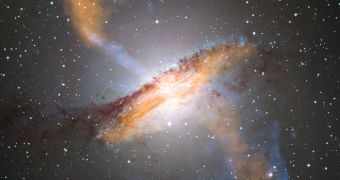Astronomers at the Brigham Young University (BYU) determined in a new study that black holes at the core of massive galaxies are able to move laterally through their hosts too. Until now, experts believed that the dark behemoths were simply spinning at galactic centers, traveling alongside their hosts.
Interestingly, it would appear that both types of motion are responsible for creating quasars, massive objects in the early Universe that produce incredible jets of energy. The term quasar stands for quasi-stellar radio source, and it denotes an active galactic nucleus.
BYU experts showed in the new study that the lateral movements of black holes at these galactic centers are also responsible for powering up quasars. Details of the study appear in the latest issue of the esteemed journal Proceedings of the National Academy of Sciences (PNAS).
Quasars are widely regarded as the brightest sources of light in the Universe. Astrophysicists have been wondering about what is powering these objects for many years, but thus far studies on the types of fuel the galactic nuclei may be using have been largely ignored.
The quasar itself is powered by a structure called an accretion disk, which forms around supermassive black holes that are in the habit of gulping up a lot of matter from their surroundings. These discs are made of debris and gas, and are heated to millions of degrees.
This causes them to release vast volumes of radiation in all portions of the electromagnetic spectrum, and produce impressive jet-like stream. The Centaurus A spiral galaxy is renowned for the monumental jets it displays.
“The black hole is like a generator spinning around in these magnetic fields. The way the field lines get twisted around and pulled by the spinning black hole creates electromagnetic tension that gets turned into radiation and energy that goes out,” saysDavid Neilsen
The expert, a professor at BYU, is the lead author of the study. He explains that the jets emanating from Centaurus A are about 1 million light-years long. It would appear that the lateral motion of the black hole in this galaxy is partially responsible for this.
“Rotational kinetic energy contributes, but the simple movement like a billiard ball can also contribute to this,” adds study coauthor and BYU professor Eric Hirschmann.
“The two processes don’t compete with each other, they combine with each other to give you the overall energy that streams away from the black hole,” he goes on to say.

 14 DAY TRIAL //
14 DAY TRIAL //